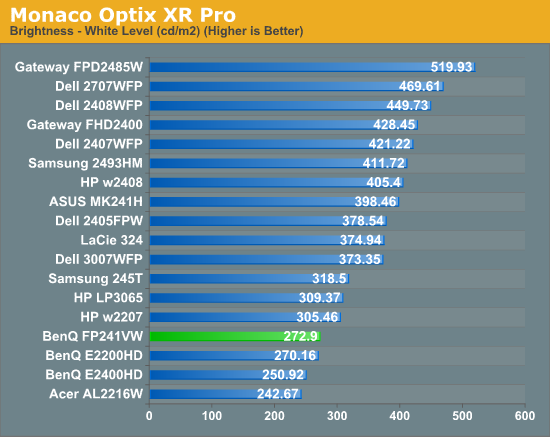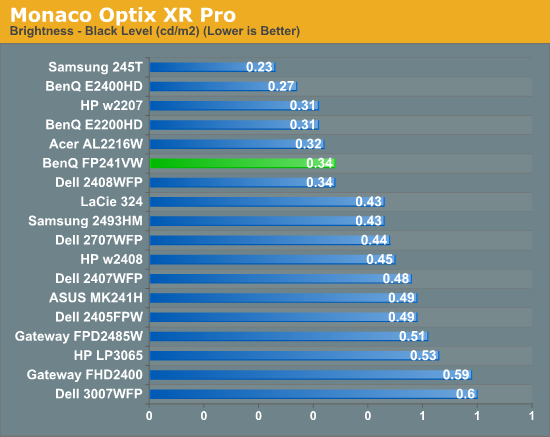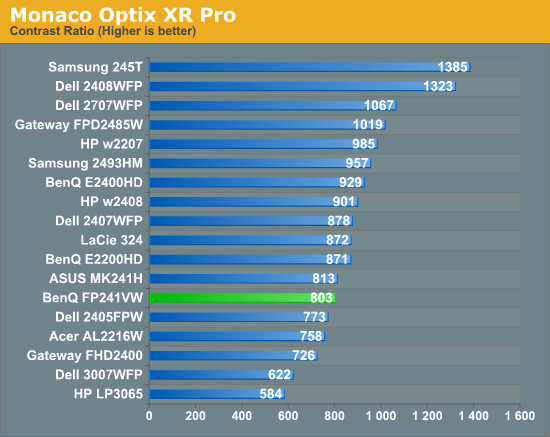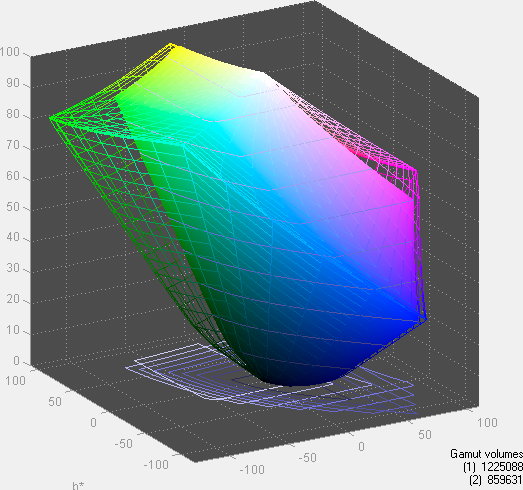Brightness and Contrast Ratio
For the brightness, contrast, and color accuracy tests, we depend on a hardware colorimeter and software to help calibrate the displays. We use a Monaco Optix XR (DTP-94) colorimeter and Monaco Optix XR Pro software, and we also test with ColorEyes Display Pro. Results in nearly every case have been better with Monaco Optix XR Pro, so for this article we're skipping the ColorEyes Display Pro results. We didn't perform a complete evaluation of the FP241VW, so we're missing maximum/minimum brightness results, but in general the display performs similarly to other LCDs.



Don't pay too much attention to the white/black graphs, as they are merely reference points for how the displays perform at certain settings. Like many other LCDs, the FP241VW has a "normal" brightness level of ~270 nits, which is more than sufficient and is actually brighter than what most users prefer to use in an office environment. You can reach the advertised 500 nits brightness if you adjust contrast and color levels as well. More important than brightness levels is the contrast ratio at the various settings. We measured a contrast ratio of 800:1 with the FP241VW, which is a decent result placing it in the lower mid section of our charts. While higher scores are better, in reality anything above 500 is sufficient for most users (i.e. the HP LP3065 that we like is at the bottom of the chart). Also, we wouldn't worry about any advertised dynamic contrast ratio numbers - at least not if you want consistent colors.
Color Gamut
Below is a comparison of color gamut for the LCDs we've tested. We use Gamutvision, a utility developed by Imatest LLC, to calculate color gamut. We compare the color profiles of the LCDs to the Adobe RGB 1998 color profile and report the results as a percentage - higher being better.


So far, color gamut has generally fallen into one of two categories: either +/-95% or +/-75%. Color gamut is determined almost exclusively by the backlighting, and the BenQ FP241VW falls short of other high-end LCDs in this area. In fact, it's at the bottom of the chart (though the difference between 70% and 75% isn't something you're likely to notice, so the bottom grouping essentially is a tie). For the original price, we would expect better, and if AU Optronics updates this particular panel we would definitely like to see a better backlight. Ideally, what we would like to see from more manufacturers is the use of LED backlighting - you can get extremely high color gamuts using RGB LEDs, and power requirements are also lower than traditional CCFL backlights. It's important to keep things in perspective, however: 70% may seem very low, but if you are using the standard sRGB profile (Windows' default) these LCDs look fine. It's only in applications like Adobe Photoshop with its expanded color space that you might notice a difference between the display color gamuts.










114 Comments
View All Comments
JarredWalton - Wednesday, June 17, 2009 - link
The glossy vs. matte debate is one of those areas that comes down to personal preference. Me, I really dislike glossies - and I know plenty of others that feel the same. However, I also know people that prefer glossy displays. More power to 'em, but I'm not going to encourage the trend. :-)photoguru - Wednesday, June 17, 2009 - link
- Vizio 32" LCD Full HDTV (VO32LFHDTV10A) - $527 at Sam's Club USI've swapped out my 20" Apple Cinema Display for this 32" TV and I was completely shocked at the quality of the panel. If you run your image through one of the HDMI inputs text looks crisp and it even can run PIP for watching TV while working.
I am a creative director and so I spend a lot of time staring at screens working on print, web, and television programs... I would like to have an LED back lit screen but for the money this thing is ridiculous.
iwodo - Wednesday, June 17, 2009 - link
Are there any major different between panel type in terms of power consumption?And i really do hope either TN solve their "in-viewable" vertical viewing angle. ( Sorry "poor" in your article simply would not justify it ) with special coating that has been developed for a long time but there are yet wide spread of use.
Or E-IPS will give the best performance per dollar. TN is possible the worst invention for Display Monitor history in All times.
aceh0 - Wednesday, June 17, 2009 - link
The FP241VW launched in early 2007 and had nearly a two year run. Street pricing was under 500$ near the end of the product life cycle.
evilspoons - Wednesday, June 17, 2009 - link
I found an missing-box demo model at a local computer store for $250, but I passed on it seeing the noticable lag between moving the mouse and seeing the cursor respond. That, and the asinine stand, made me keep looking. I hate my 22" Gateway monitor (it does a terrible job dithering) but I'm not going to spend money on virtually the same thing as a replacement, either (i.e. any other new monitor).I tried to buy an IPS 24" HP monitor a few months ago (lp2475w) but the distributor I attempted to order from jacked the price up $200 (from $700 Canadian to nearly $900 - ouch) in the time between me placing the order and it shipping, so I just cancelled.
Then... I just gave up entirely because I realize I spend 99% of my computer time on my MacBook Pro now and I have to live with its LCD. Ha.
erple2 - Wednesday, June 17, 2009 - link
Why not just buy directly from hp? They have it for 729 Canadian dollars. Was it really that much cheaper when you got it from the distributor than directly from hp?JarredWalton - Wednesday, June 17, 2009 - link
Sorry for the error; I have clarified things now I hope. You're right that it first came out in 2007, but I believe it was announced early 2007 and actually available round about Sept/Oct. Anyway, it is discontinued, unfortunately just around the time the pricing was becoming desirable. You can find them online still at some places, but no major resellers carry them anymore so you'll have to take a bit of a chance if you buy one these days.IlllI - Wednesday, June 17, 2009 - link
"The vast majority of LCDs these days are TN panels, and the trend appears to be moving even more in that direction. With a soft economy, many are looking for any way to save money, and even those who really like quality displays may be willing to settle for a less expensive TN panel"while TN is indeed cheapest, you can actually get a 22in e-ips lcd for around (or sometimes under) $200. while not as good as the more expensive ips panels, it is (in my opinion) better quality than TN. certainly, you guys know of it? http://forums.anandtech.com/messageview.aspx?catid...">http://forums.anandtech.com/messageview.aspx?catid...
Grooveriding - Wednesday, June 17, 2009 - link
It's a real shame the tendency towards TN these days. Most consumers are just not informed as to the much more satisfying experience given by PVA/IPS panels.If you can get someone to sit in front of a TN and high quality monitor side by side that is usually enough to settle it, of course for some image quality is not a concern. For the enthusiast hardware user though, it usually is.
I have an older LG246WP-BN which is a fantastic screen with great quality as well as a Dell 2408. Reading this article has made me think my eyes are bad though, as I prefer the IQ on my LG to the Dell, which according to this review ought to be superior with it's more modern panel tech.
The0ne - Thursday, June 18, 2009 - link
Consumers are mostly going to want something average with a good low price. This isn't going to go away. And on most of their part they don't really care whether it's a TN panel or better because as long as it's "clear" and they like it then they'll buy it.I'll use myself as an example. I have 2 Dell 3007wfp-hc, 1 2407wfp, 2 22" viewsonics, 1 Acer 24" with TN, and 1 Acer 22" with TN. My main computer uses the 3007's of course but even when I switch to the other panels I rarely care. That's because the content I'm working with really doesn't require the extra 5-15% gamut, high contrast and so forth.
Now if I really really care about colors, brightness, details and what have you then sure I'll spend the extra money on better panels and features. But then again why wouldn't I spend it on the medical LCDs :)
I am pretty sure many of you commenting about wanting/needing a better than TN panel actually don't care whether you do or not on a daily basis. If you do you'll be a stickler like my co-worker who spends time paying attention to ghosting, blurs, etc EVERY time he uses his TV. I'm pretty sure many of you don't do this nor have the time to do this. If you do then....well, no comment. :)